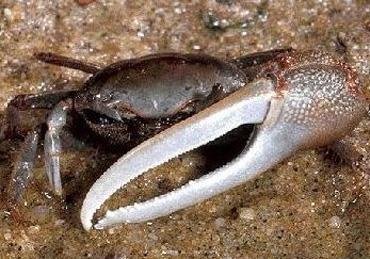The male fiddler crab is quite the show-off. To attract the attention of females, he stands outside his burrow and waves his large claw in the air. And as the girls get closer, the waving becomes more and more frantic.
 Male fiddler crab. Credit: National Oceanic and Atmospheric Administration
Male fiddler crab. Credit: National Oceanic and Atmospheric AdministrationBut that big claw may also play a role in the male crab’s everyday life -- it may help keep his body at the right temperature.
All fiddler crabs have two claws. Females have two small ones, while males have a small one and a large one. The little claws are used for feeding -- the crab scoops some sediment into its mouth, filters out microscopic organisms, then spits out the dirt and rock.
The big claw, which can account for up to half of the crab’s body weight, is used to attract mates and to scare off rivals. And the bigger the claw, the more successful the crab at finding a mate and reproducing.
The claw comes with a cost, though. It takes a lot of energy to grow a large claw and to wave it around in the air. But researchers at the University of Texas Marine Science Institute found that the claw also has some physical benefits: it helps regulate the crab’s temperature.
To discover this, the scientists put several crabs under heat lamps, and found that the males with the big claw were much better at shedding the extra heat. The results suggest that the claw can help regulate temperature in all conditions -- shedding heat when it’s hot, and storing it when it’s cool. Because even in the world of fiddler crabs, a guy wants to stay cool when he’s showing the girls how hot he is.

